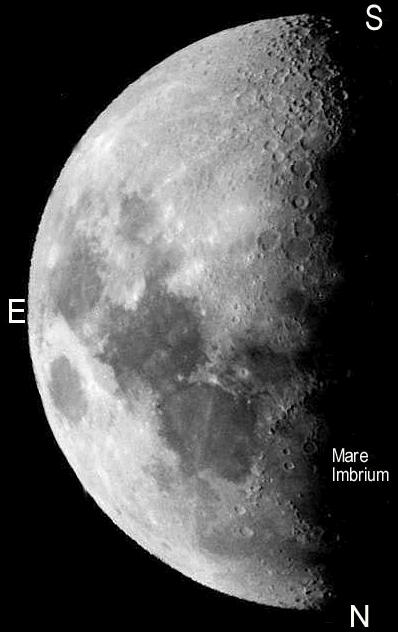Observing the Moon - Intro to the First Quarter
Jack Kramer
The first quarter moon is a popular phase for many lunar observers because it's easy to observe and has lots of detail. For one thing, it's well up in the sky when the sun sets, and it stays up until about midnight.
I took the following photograph* just at first quarter phase and oriented the moon as it appears in most astronomical telescopes, with south up and the image reversed right-to-left. Although the illuminated half of the moon is facing to the west as seen in our sky -- toward the sun -- this is actually the lunar east side.

While a thin crescent moon low in the west may be dramatic, a telescope shows a fairly bland surface at the edge, or limb, of the moon. Recall that when we're looking toward the limb of the moon, we're seeing the features at an oblique angle, which means things like craters are considerably foreshortened -- they appear long and narrow. But at first quarter, we're seeing features toward the center of the moon in a more face-on aspect.
Experienced moon watchers plan their observing to catch certain features when they're near the terminator. The terminator is the edge between the light and dark parts of the moon. It's the point of lunar sunrise or sunset, so features stand out boldly here due to the longer shadows. In the photo, you can pick out features that are just partly illuminated; they appear as little points of light just beyond the terminator. These are mountain peaks or the high points of crater walls that are catching the first rays of a rising sun, while their bases are still in darkness. The lack of shadows on a full moon explains why many features seem to disappear from view at that time of the lunar month.
Notice that around first quarter there's some difference in the types of features visible between the northern and southern hemispheres. In the north ("down" in the photo), there's an abundance of maria (the dark "seas"). On the other hand, there's an abundance of rugged craters in the southern hemisphere around the central meridian, which is why this area is often referred-to as the "Southern Highlands". Note too that, unlike in the south, there are a number of long mountain ranges in the north. These mountain ranges are especially prominent around the large Mare Imbrium basin, which lies just at the terminator and is only partially visible at this phase. Mare Imbrium is one of the most highly detailed areas of the moon, and with each succeeding night, more of it becomes visible as the terminator marches toward the lunar west.
If you recall the differences in topography, you won't get lost when visiting the moon via telescope. At least you'll know which hemisphere you're in! Finally, if you become expert on the surface features of the moon, you could add the title "selenographer" to your resume. (Selenography is the lunar equivalent of geography on the Earth.)
* Info on the photo: negative projection (using a Barlow lens without a telescope eyepiece or camera lens) through a 4-inch refractor at 1/8 second on Kodacolor Gold 400 film. It's a composite of two photographs that were scanned and combined electronically using Adobe Photo DeLuxe software, after which the image was converted to grey scale.
Published in the May 1999 issue of the NightTimes




